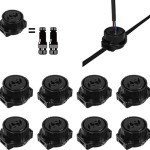Outdoor Wooden Furniture Paint Colours: A Comprehensive Guide
Outdoor wooden furniture can significantly enhance the aesthetic appeal and functionality of patios, decks, and gardens. However, exposure to the elements necessitates a protective finish that can withstand sun, rain, and temperature fluctuations. Choosing the right paint color is crucial, as it not only contributes to the overall design but also influences the longevity and maintenance requirements of the furniture. This article provides a comprehensive guide to selecting suitable paint colors for outdoor wooden furniture, considering factors such as climate, style, and practical considerations.
The selection of an appropriate paint color for outdoor wooden furniture involves a balance between personal preference and practical considerations. Dark colors, while aesthetically pleasing, can absorb more heat, potentially leading to increased expansion and contraction of the wood, which can contribute to premature cracking and warping. Lighter colors, conversely, reflect sunlight and can help to keep the furniture cooler. The surrounding environment also plays a role; the color should complement the landscaping, the architectural style of the house, and any existing outdoor decor. Furthermore, the chosen color should be easy to maintain and should not show dirt and stains too readily.
Understanding Exterior Paint Types and Their Properties
Before delving into specific color options, it is essential to understand the different types of exterior paints available for wooden furniture and their respective properties. Acrylic latex paints are a popular choice due to their flexibility, durability, and water resistance. They are also relatively easy to apply and clean up. Oil-based paints, while offering excellent adhesion and resistance to abrasion, require more involved cleanup procedures and can be more prone to cracking over time. Alkyd paints are a hybrid of oil-based and latex paints, offering a balance of durability and ease of application. Each paint type interacts differently with colors, affecting the final appearance and longevity of the finish.
Furthermore, the gloss level of the paint plays a significant role in both aesthetics and protection. High-gloss paints offer the most durable and easiest-to-clean finish, making them suitable for furniture that is frequently used or exposed to harsh conditions. Semi-gloss paints provide a good balance of durability and sheen. Satin paints offer a softer, more subtle finish, while matte paints provide a non-reflective surface that can be ideal for achieving a rustic or weathered look. However, matte paints tend to be less durable and more difficult to clean than higher-gloss options.
The underlying wood also influences the choice of primer and paint. Certain wood species, such as redwood and cedar, contain extractives that can leach through the paint and cause discoloration. In such cases, a stain-blocking primer is essential. The primer ensures proper adhesion of the paint and provides a uniform surface for the color to adhere to, resulting in a more consistent and durable finish.
Exploring Popular Colour Palettes for Outdoor Wooden Furniture
The range of available paint colors for outdoor wooden furniture is vast, allowing for a high degree of customization. However, certain color palettes consistently prove popular due to their aesthetic appeal and practicality. Neutral colors, such as white, beige, gray, and brown, are versatile and blend seamlessly with most outdoor environments. White furniture creates a clean and airy feel, while beige and brown tones offer a more natural and earthy aesthetic. Gray furniture provides a sophisticated and contemporary look.
For those seeking a more vibrant and eye-catching look, bolder colors such as blue, green, red, and yellow can be effective. Blue and green tones evoke a sense of tranquility and harmony with nature, while red and yellow add warmth and energy to the outdoor space. However, it is important to use these brighter colors judiciously, as they can fade more quickly in direct sunlight. Consider using them as accent colors on smaller pieces of furniture or incorporating UV-resistant additives into the paint to prolong their vibrancy.
Pastel colors, such as light pink, lavender, and mint green, offer a softer and more romantic aesthetic. These colors are particularly well-suited for cottage-style gardens and outdoor spaces with a vintage or shabby-chic theme. However, pastel colors can be more susceptible to fading and may require more frequent touch-ups. The choice of color should complement the overall style and atmosphere of the outdoor space.
Furthermore, consider the existing colors in the surrounding environment. If the house is painted in a certain color, the furniture should complement it. Similarly, if the garden is filled with colorful flowers, the furniture should either blend in or provide a contrasting backdrop. Observing the existing color scheme and taking it into account when selecting a paint color will help to create a cohesive and harmonious outdoor space.
The application of color theory can also be beneficial. Complementary colors, which are located opposite each other on the color wheel (e.g., blue and orange, red and green), can create a dynamic and visually stimulating effect. Analogous colors, which are located next to each other on the color wheel (e.g., blue, blue-green, and green), offer a more harmonious and relaxing feel. Understanding these principles can help to guide the selection of paint colors and create a more visually appealing outdoor space.
Practical Considerations and Maintenance Tips
Beyond aesthetics, practical considerations play a crucial role in selecting the right paint color for outdoor wooden furniture. Dark colors absorb more heat from the sun, which can lead to the wood expanding and contracting, potentially causing cracks and warping over time. Lighter colors reflect sunlight and keep the furniture cooler, reducing the risk of damage. In hot and sunny climates, lighter colors are generally a more practical choice.
The level of maintenance also needs to be taken into account. Dark colors tend to show scratches and imperfections more readily than lighter colors. If the furniture is likely to be subjected to heavy use or rough handling, a lighter color may be a more practical choice. Furthermore, certain colors are more prone to fading in direct sunlight. Red and yellow pigments, in particular, can be susceptible to fading. If the furniture will be exposed to prolonged periods of sunlight, consider using paints with UV-resistant additives to prolong the vibrancy of the color.
Regular cleaning and maintenance are essential for preserving the appearance and longevity of painted outdoor wooden furniture. Wipe down the furniture regularly with a damp cloth to remove dirt and debris. For more stubborn stains, use a mild soap and water solution. Avoid using harsh chemicals or abrasive cleaners, as these can damage the paint finish. Inspect the furniture regularly for signs of damage, such as cracks, chips, or peeling paint. Repair any damage promptly to prevent it from worsening.
Re-painting or touching up the paint finish is generally recommended every few years, depending on the climate and the level of exposure to the elements. Before re-painting, thoroughly clean the furniture and sand down any rough or damaged areas. Apply a fresh coat of primer to ensure proper adhesion of the new paint. Choose a high-quality exterior paint that is specifically designed for wooden furniture. Following these maintenance tips will help to keep the furniture looking its best for years to come.
The use of outdoor furniture covers during periods of inclement weather or when the furniture is not in use can also help to protect the paint finish and prolong its lifespan. Covers protect the furniture from sun, rain, snow, and other environmental factors that can cause damage. Choose covers that are made from breathable materials to prevent moisture buildup, which can lead to mold and mildew growth.
Ultimately, the choice of paint color for outdoor wooden furniture is a personal one, but considering the factors outlined in this article will help to make an informed decision that balances aesthetics, practicality, and durability. The selection of the appropriate paint type, color, and maintenance routine can significantly impact the longevity and visual appeal of outdoor furniture.

How To Paint Your Outdoor Furniture Dulux

Painted Wood Patio Furniture Rust Oleum

15 Tips For Painting Outdoor Furniture To Last Longer

Garden Furniture Paint Ideas 12 Easy And Colorful Updates Gardeningetc

Painting The Outdoor Furniture How I Got That Barnwood Color

Reviving Old Wood Outdoor Furniture With A Coat Of Paint Patio Makeover

Rainbow Wooden Outdoor Patio Furniture Makeover With Spray Paint Mimosas Motherhood

How To Paint Outdoor Furniture So It Lasts For Years The Happy Housie

Renew Outdoor Furniture With Spray Paint A Cook And Her Books

Rainbow Wooden Outdoor Patio Furniture Makeover With Spray Paint Mimosas Motherhood
Related Posts







